Uncle Ez's Atomic Bomb
So, Santa has finished his annual stint of overseeing the Garden of Eden, and God has finished another stint of shopping mall photography, and all is right in the world, and... whoa! What’s this?
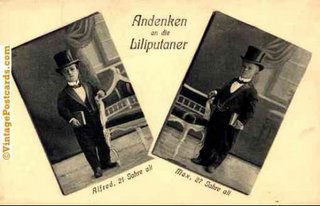
Oh, Look! The Quantum Physicists Have Been Splitting Atoms Again.
Quick, which subatomic particle are you? Alfred on the left? Max on the right? What an enigma. It’s true, though, you know: once light passes through the lens of the eye, it is like the twin Helixes of a DNA molecule.
Upside down!

Check Out Gorgeous at Whyfiles.org today!
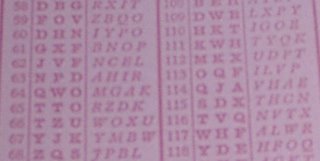
Image of Alfred and Max Cast Upon the Retina
German Enigma Machine Codebook Captured from UBoot 505 in World War II.
Note the nifty water-soluble pink ink on pink paper.
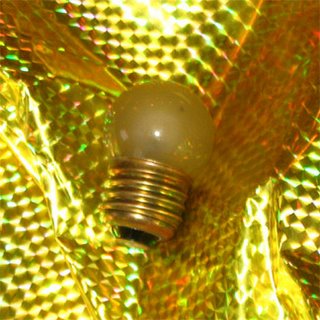
A Solution Birthing at the Heart of the Sun
The poets got pretty handy with decoding God’s Word, too. Take the case of that modernist poet and radio broadcaster, Ezra Loomis Pound, for instance. Ez got his head around the problem a century ago, too, even before the German Enigma Machine was patented in 1918. Here’s the image that tipped Pound off at the outbreak of World War I that there was something going on that nobody knew anything about:

Ezra Pound’s Conspiracy Theory
Is it a map of the German and French lines at Verdun?
Is it an early map of the German Atomic Bomb?
No! It’s the Magnetic Lines of Force Around the Poles of a Bar Magnet
as Shown by Iron Filings!
Note the Black Hole at the centre.
Who knew?
Yes, kids, you can build a black hole like this at home!
Pound should have come to the circus, shouldn’t he! Alfred and Max could have set him straight. Or, at least, they could have made him take a second look. But, then, Pound was a serious character. As American novelist Gertrude Stein said of him in Paris a few years later: "He talks like a village....Which is all right if you’re a village."
It’s like the Austrian playwright Thomas Bernhard’s play "Force of Habit" (die Macht der Gewohnheit), in which a circus director has spent twenty years trying to transform his circus into a string quintet, so they could play something truly very edifying and important: Schubert's Trout Quintet. Check out composer Thomas Adès, tickling those fish.

The Effect of Heavy Water on Truly Very Important Music
Water Soluble Formal Attire Required
Note Walt Disney’s first animated sketches at the right.
(For a closer view, click on the link and scroll down.)
In Force of Habit, Bernhard’s circus troupe spends twenty years refusing to practice. In doing so they use every bit of theatrics, slapstick, and gymnastics in their not inconsiderable repertoire. By the time we arrive, it’s the night before their inaugural performance of Schubert. It soon becomes clear that their circus has collapsed because of their neglect, while their transformation into high artists has failed because of their inability to be earnest. The circus director is beside himself with frustration.
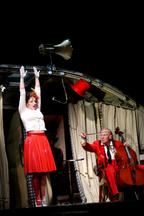
The Evanescence of Being Earnest
from the Vienna Burgtheater Production of Thomas Bernhard’s Die Macht der Gewohnheit.
(For more pictures, just fingertiptoe your way over to their site and click "Szenenphotos", in the central (red) column.
What is remarkable about Bernhard’s play, is that the play is in verse, and the action and words of the play are in the rhythms of, you guessed it, Schubert’s Trout Quintet, right down to the lion tamer, his mauled hand crudely bandaged, pounding on the piano in spite, in just the right chords, at just the right time.
Bang! Bang! Bang!
It’s enough to make a guy think there’s no way to escape the Trout Quintet.

What is It?
God and a Friend Trying and Not Trying to Escape the Trout Quintet?
Alfred and Max Later in Life, Not Knowing Whether They Should Laugh or Cry?
No, it’s the 1997 Hungarian Production of Bernhard’s "Force of Habit."
Notice that after the rusting of the Iron Curtain, Hungarian Circus directors appear to wear American corduroy jackets and, by the looks of it, cufflinks.
Oh, yes, that’s funny, guys.
But that’s Pound’s problem, too, isn’t it: seriousness. In this world. I mean, come on. In this world, in which there are more genes in a grain of rice than in a human being?
Ezra!

Reverse Evolution: Rice Pudding Being Eaten by a Human
During a Danish Christmas Feast
Somewhere in that pudding is a whole almond.
But that was Ezra: poetry as cufflink. Yessirree, Ladeeeeeees and Gentlemennnnn! While other young men of Ezra’s generation were creating art out of their bodies in the French and Belgian mud, he was looking into the glorious European past, trying to save the poetry in it by making it into a machine.
Not surprisingly, Ezra Pound’s slogan was: Make it New!
Here’s a snatch of Ezra which I had when I was a boy on the pear orchard, before I ever heard of Ezra:

By the looks of it, if Ezra had been a young man in the 1960’s,
he wouldn’t have had a 19th Century intellectual’s dream of a 12th Century poet’s beard,
but he would have had real nifty sideburns.
But Pound was looking back to the 19th and 12th centuries, and the other side of this particular quantum coin, of course, was the old 19th century proverb:
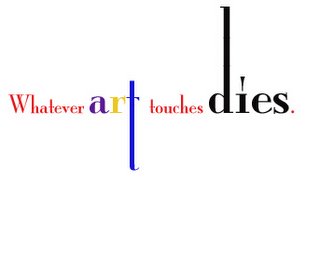
Looking for the Trout in the Trout Quintet
Notice God’s blue fishhook.
That’s right: God forgot the bait.
But a bare hook was good enough for Ezra...
Ah, yes. Baitless, hooked, and caught, then, that’s our Ezra, and to put the divided world back together again, he hit on the idea that a poet could write a poem by setting one word beside another word beside another word, without drawing a single conclusion between them. What he had in mind was Chinese ideogrammatic writing, such as that from the top of the poem below, which he translated in 1914, as part of the action of the world going to war.

The Cutting Edge of Practical Mathematics in the Early 20th Century
A First Attempt at Decoding the Genetic Code of Rice
What he created, though, was a kind of atomic bomb. To hell with trench warfare. I mean, how old!
Rightfully enough, in an interview with Robert Enright in Border Crossings 96, the Belgian artist Wim Delvoye notes:
This is, I take it, good news, because a century on, the attempt at outrunning death continues, even though death has claimed Ezra Pound and all his lovers, while his readers are still wandering into the magnetic entrapment fields of his poetic grids and still going zzzzzztttt like a mosquito trapped in a mosquito bat with rechargeable batteries right in the handle.
This particular atomic bomb was the speech of God.
Indeed. Here is Ezra and his reunited Lover, as Wim Delvoye found them in their eternal romantic bower:
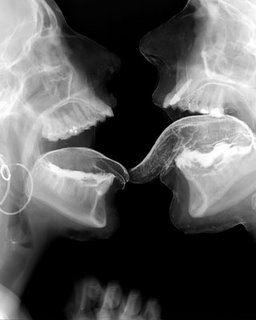
Poet Reuniting With His Reader?
Kiss 2, X-Ray art, Wim Delvoye, 2000
Notice the black hole in the background. Source.
Now, of course, in, Gasp! 2006, Pound’s cryptograms of rice farmers in ancient China are just, maybe, starting to appear more than a little quaint: precious relics of old emotional technologies.
Here’s an example:

A Fragment of Old Emotional Recombinant Gene Technology
from Ezra Pound’s Poetic Lab in Kensington. 1914
Art used to rely on devices like, but now, as Wim Delvoye illustrates, it is hardwired.
That’s to say: in his lab, Pound combined and recombined images of the body. Now the body itself has become the art. Now the cryptograms are taking place in DNA itself. Now, art is the ultimate in plastic surgery!
And even so, with his tea parties, Ezra was there first. Spooky.
If it’s proof you want, here you go:
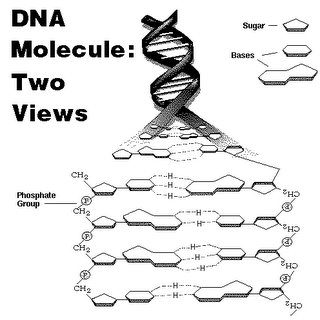
Ezra Pound’s Poetics Independently Verified,
as found in an early 21st century geneticist’s codebook.
Notice how the right hand code is reversed.
Rice. That’s what Ezra and the geneticist were both translating. A simple dish, really: simple old genetically superior rice. One of the grains that founded civilization and sustained it for millennia.
So, here’s how it works: in the old biological technologies, in the art of cooking, you set the genetically mellow rice in a blue pottery dish beside your steaming plate of Thai green curry, and enjoy the way it cuts through the sharpness on the tongue.
(Nostalgia like that has always been the most popular form of art.}
Still, in the spirit of scientific adventure, you understand, with our pith helmets and our elephant guns, in the new art, here’s what happens when you cross rice with people.
To whet your appetite, here’s a quote from that little feast:
Hey, artists and poets could have told them that. The people of Vietnam could still tell us that.

U.S. planes spray the defoliant Agent Orange over the rice paddies of southern Vietnam. 1966.
Anyway...
Ladies and Gentlemen, you can see what I’m up against. This is why, I searched the web high and low to find a way for you to test the results of this cross-species gene transfer, this avian flu of the rice-human continuum, shall we say, for yourself.
Yes, you, too, get to put Pound’s futuristic technique to the sophisticated 21st century test.
Ready?

Verification Test of the New and Old Aesthetic Technologies
You can see the original (and more) by clicking here.
Feel better?
Good.
Just remember: here again, Pound was there before us. The method behind the madness of Ezra Pound was that he was trying to take the machine age and humanize it. The poem would come about for Pound when the reader read it: it was the reader who put all the scattered links together. The jolt of energy the mind formed between words, that was the thing Pound wanted to force the reader to create. In fact, he wanted the reader to create the poem.
No passive readers for him. No acceptance of the transparent connect between word and sense. No ‘tree’ = ‘tree’. Nosirree!
In fact, after awhile, he even stopped translating the Chinese:

Fragment from Pound’s Cantox XLIX
Poem as Enigma Code
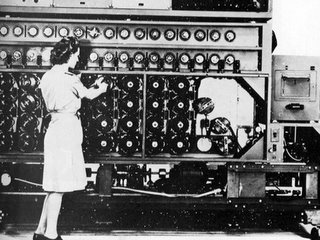
One of Pound’s Readers Decoding One of Pound’s Poems During World War II
Machine for Decoding the Enigma Machine
Maybe.

Take two of these and call me in the morning.
(Before it finishes dividing into two.)
Next week: Where to look, the Three Little Pigs, Mussolini, and Santa Claus’s arch enemy.

Quick, which subatomic particle are you? Alfred on the left? Max on the right? What an enigma. It’s true, though, you know: once light passes through the lens of the eye, it is like the twin Helixes of a DNA molecule.
Upside down!
Adam: Shoot.
Harold: Not to worry, Adam, because that takes us to our mascot of the week: Gorgeous Genome!

Eve: Oooooh. Nice biceps, Gorgeous.
Gorgeous: And the hair. Don’t forget the hair!
Adam: Ooooooh. Llovely sideburns.
Harold, the Circus Director: Yes, folks, over there at Gorgeous Genome, you will get to fill in a genetic scratch and win ticket:Checking the Human Genome
Note the levitating hand!
Eve: I don’t like those. Mine always come up: Better Luck Next Time!
Adam: Here. Maybe you’re not scratching in the right place.
Eve: Ahhhh!! Yes. Mmmmmmmmm.
Harold, the Circus Director: Ahem! (Blushes.) And Gorgeous will teach you the secret behind this nifty bit of code:GGCACGAGGGTAAATATGGCATAAGTTAATAACA
CTTTTCCCCAAAATGGTGCTTTGGATTTGAAAAGG
GTCTGATGGGGAGAAGGAGAACGTATCATCCTAGC
TTCCTCTCTTAATAAACCTAGAAAAACGGGTAGTA
AACTGTGGATAGTCAGGAAAACACCCAGCAAGGGA
CACAGC TGTCAGGAAATGAATCTTCCCCCCAACCC
CCACCATGCAGATGGATAGACAGAATCTTTCCTGA
CTAGTCATTAGGATCAGGGGCCTCTGTTGGATTTGT
GTTTCTTGAAGAATAGCTGGCAGAGTGGTATAAAA
GACACGAATATCTCCTGGTCTATAAGGATACTCTGA
TTTGGGGTTTGCATTTTTCATGGTTTTTATTTCCTGT
TCCCCCTGGAGTTTTCCATTAGTGAGTTTTTG
Eve: Oh, that was when God’s typewriter was on the fritz. There were only a few letters working. Do you remember that, dear?
Adam: Yes, I do. And the Caps Lock was stuck down, too.
Eve (turning to face the audience in the Big Top): He got himself his first Commodore 64 soon after that.
Adam: And there was no looking back!
Harold, the Circus Director: So, go on over to Whyfiles.org Today! (Harold draws the curtains.)
Eve: Why, Harold?
Adam: Yes, why, Harold?
Harold: Because the brain is going to have to decode those particles of light before they can be turned into art.
Eve: But it’s old technology. Make it new!
Adam: Yeah. You need something closer to your own time. How about this:

German Enigma Machine Codebook Captured from UBoot 505 in World War II.
Note the nifty water-soluble pink ink on pink paper.
Adam: The thing is: the physicist and cryptographers were not the only ones to set themselves this puzzle, and not the only ones to come up with a solution.
God (coming out of the woodwork): Sometimes the smallest things can have the biggest consequences.
Santa Claus (lurking by the wiling poinsettas): How about this?

Eve: Awwww....What a great idea! Adam, look at that cute little thing! Let’s get one!
Adam: GGCACGAGGGTAAATATGGCATAAGTTAATAACA
CTTTTCCCCAAAATGGTGCTTTGGATTTGAAAAGG
GTCTGATGGGGAGAAGGAGAACGTATCATCCTAGC
The poets got pretty handy with decoding God’s Word, too. Take the case of that modernist poet and radio broadcaster, Ezra Loomis Pound, for instance. Ez got his head around the problem a century ago, too, even before the German Enigma Machine was patented in 1918. Here’s the image that tipped Pound off at the outbreak of World War I that there was something going on that nobody knew anything about:

Is it a map of the German and French lines at Verdun?
Is it an early map of the German Atomic Bomb?
No! It’s the Magnetic Lines of Force Around the Poles of a Bar Magnet
as Shown by Iron Filings!
Note the Black Hole at the centre.
Who knew?
Yes, kids, you can build a black hole like this at home!
Pound should have come to the circus, shouldn’t he! Alfred and Max could have set him straight. Or, at least, they could have made him take a second look. But, then, Pound was a serious character. As American novelist Gertrude Stein said of him in Paris a few years later: "He talks like a village....Which is all right if you’re a village."
It’s like the Austrian playwright Thomas Bernhard’s play "Force of Habit" (die Macht der Gewohnheit), in which a circus director has spent twenty years trying to transform his circus into a string quintet, so they could play something truly very edifying and important: Schubert's Trout Quintet. Check out composer Thomas Adès, tickling those fish.

Water Soluble Formal Attire Required
Note Walt Disney’s first animated sketches at the right.
(For a closer view, click on the link and scroll down.)
In Force of Habit, Bernhard’s circus troupe spends twenty years refusing to practice. In doing so they use every bit of theatrics, slapstick, and gymnastics in their not inconsiderable repertoire. By the time we arrive, it’s the night before their inaugural performance of Schubert. It soon becomes clear that their circus has collapsed because of their neglect, while their transformation into high artists has failed because of their inability to be earnest. The circus director is beside himself with frustration.

from the Vienna Burgtheater Production of Thomas Bernhard’s Die Macht der Gewohnheit.
(For more pictures, just fingertiptoe your way over to their site and click "Szenenphotos", in the central (red) column.
What is remarkable about Bernhard’s play, is that the play is in verse, and the action and words of the play are in the rhythms of, you guessed it, Schubert’s Trout Quintet, right down to the lion tamer, his mauled hand crudely bandaged, pounding on the piano in spite, in just the right chords, at just the right time.
Bang! Bang! Bang!
It’s enough to make a guy think there’s no way to escape the Trout Quintet.

God and a Friend Trying and Not Trying to Escape the Trout Quintet?
Alfred and Max Later in Life, Not Knowing Whether They Should Laugh or Cry?
No, it’s the 1997 Hungarian Production of Bernhard’s "Force of Habit."
Notice that after the rusting of the Iron Curtain, Hungarian Circus directors appear to wear American corduroy jackets and, by the looks of it, cufflinks.
Oh, yes, that’s funny, guys.
But that’s Pound’s problem, too, isn’t it: seriousness. In this world. I mean, come on. In this world, in which there are more genes in a grain of rice than in a human being?
Ezra!

During a Danish Christmas Feast
Somewhere in that pudding is a whole almond.
Adam: Mmmmm. If you get the almond, you get a box of chocolates, eh.
Eve: At least it’s not a pear!
God: Harold, if all that whipped cream has you worried about your arteries, relax:Death statistics for cardiovascular disease in males in various countries:
1167 deaths per 100,000 population. Russia 1998.
348 deaths per 100,000 population. United States, 2000.
316 deaths per 100,000 population. Denmark 1998.
280 deaths per 100,000 population. Canada, 1998.
186 deaths per 100,000 population. Japan, 1999.
Harold: Whew.
But that was Ezra: poetry as cufflink. Yessirree, Ladeeeeeees and Gentlemennnnn! While other young men of Ezra’s generation were creating art out of their bodies in the French and Belgian mud, he was looking into the glorious European past, trying to save the poetry in it by making it into a machine.
God:Which is, of course, pretty much exactly the same thing.
Not surprisingly, Ezra Pound’s slogan was: Make it New!
Here’s a snatch of Ezra which I had when I was a boy on the pear orchard, before I ever heard of Ezra:

he wouldn’t have had a 19th Century intellectual’s dream of a 12th Century poet’s beard,
but he would have had real nifty sideburns.
But Pound was looking back to the 19th and 12th centuries, and the other side of this particular quantum coin, of course, was the old 19th century proverb:

Notice God’s blue fishhook.
That’s right: God forgot the bait.
But a bare hook was good enough for Ezra...
God: as it should be when hooks come from God and you are named after an old testament prophet.
Santa Claus: There’s no getting around it.
Ah, yes. Baitless, hooked, and caught, then, that’s our Ezra, and to put the divided world back together again, he hit on the idea that a poet could write a poem by setting one word beside another word beside another word, without drawing a single conclusion between them. What he had in mind was Chinese ideogrammatic writing, such as that from the top of the poem below, which he translated in 1914, as part of the action of the world going to war.

A First Attempt at Decoding the Genetic Code of Rice
What he created, though, was a kind of atomic bomb. To hell with trench warfare. I mean, how old!
Rightfully enough, in an interview with Robert Enright in Border Crossings 96, the Belgian artist Wim Delvoye notes:
"When did artists start to make lithographs? When it wasn’t a decent way of mass communicating anymore. Then artists chose this out-of-date and dying printing form. At the ed of the 19th century, when offset was invented, only then do artists start to make lithographs. So when you see art doing something, you wonder if it isn’t dying."
This is, I take it, good news, because a century on, the attempt at outrunning death continues, even though death has claimed Ezra Pound and all his lovers, while his readers are still wandering into the magnetic entrapment fields of his poetic grids and still going zzzzzztttt like a mosquito trapped in a mosquito bat with rechargeable batteries right in the handle.
This particular atomic bomb was the speech of God.
God:Pretty cool technology, all right.
Indeed. Here is Ezra and his reunited Lover, as Wim Delvoye found them in their eternal romantic bower:

Kiss 2, X-Ray art, Wim Delvoye, 2000
Notice the black hole in the background. Source.
Now, of course, in, Gasp! 2006, Pound’s cryptograms of rice farmers in ancient China are just, maybe, starting to appear more than a little quaint: precious relics of old emotional technologies.
Here’s an example:

from Ezra Pound’s Poetic Lab in Kensington. 1914
Art used to rely on devices like, but now, as Wim Delvoye illustrates, it is hardwired.
That’s to say: in his lab, Pound combined and recombined images of the body. Now the body itself has become the art. Now the cryptograms are taking place in DNA itself. Now, art is the ultimate in plastic surgery!
And even so, with his tea parties, Ezra was there first. Spooky.
If it’s proof you want, here you go:

as found in an early 21st century geneticist’s codebook.
Notice how the right hand code is reversed.
Rice. That’s what Ezra and the geneticist were both translating. A simple dish, really: simple old genetically superior rice. One of the grains that founded civilization and sustained it for millennia.
So, here’s how it works: in the old biological technologies, in the art of cooking, you set the genetically mellow rice in a blue pottery dish beside your steaming plate of Thai green curry, and enjoy the way it cuts through the sharpness on the tongue.
(Nostalgia like that has always been the most popular form of art.}
Still, in the spirit of scientific adventure, you understand, with our pith helmets and our elephant guns, in the new art, here’s what happens when you cross rice with people.
To whet your appetite, here’s a quote from that little feast:
A human gene that Japanese researchers have inserted into rice enables the plant to break down a portfolio of chemicals now used on farms to kill weeds. The unusual breadth of that herbicide resistance could circumvent a major shortcoming of existing genetically engineered crops and also open new avenues for cleaning up contaminated soils.
Some scientists, however, are concerned that weeds growing with the rice could eventually acquire the human gene and become herbicide-resistant superweeds."
Hey, artists and poets could have told them that. The people of Vietnam could still tell us that.

Adam: Whatcha reading, Eve?
Eve: How to pick a good plastic surgeon. It’s pure poetry. Here’s a teaser:Dr. Derrick Antell, Plastic Surgeon: Absolutely. You can't forget that it's surgery, and there are potential complications. That's why it's critical that you invest time to pick a surgeon properly. Some people spend more time picking a toaster oven than they do their surgeon.
Eve: Oh, I have another one around here someplace. Let me see. Oh, here it is! Look at this, Adam...A Plastic Surgeon Through the Looking Glass
Adam (paging through): Hmmm...Dr. Derrick Antell: In the right hands, plastic surgery is both a complex discipline and a subtle art. The ancient and sometimes suspect practice, which took a quantum leap forward in the first decades of the twentieth century, is by definition the very essence of creativity. With a knowing eye, deft hands, and skills both learned and innate, plastic surgeons can perfect that which nature made imperfectly. They can accomplish Einstein's dream of manipulating time and undo the inexorable drag of the years on muscle and flesh. More....
Harold: Mind you, scientists need proof. A magazine article alone is just not going to do. These avant-garde artists of the anti-metaphysical need verifiable results. If they’re going to prove human redundancy in the new world order, in the now-so-serious world, the old artistic proofs of emotional integrity and resonance, those old cufflinks just won’t do, will they.....
Eve: Like: When’s the last time you wore cufflinks?
Adam: Exactly.
Harold: It’s been thirty years if it’s been a day.
Adam: The thought that we are not at the top of our mental form, that’s kind of unsettling, isn’t it.
Eve: Don’t worry. Be happy.
Anyway...
Ladies and Gentlemen, you can see what I’m up against. This is why, I searched the web high and low to find a way for you to test the results of this cross-species gene transfer, this avian flu of the rice-human continuum, shall we say, for yourself.
Yes, you, too, get to put Pound’s futuristic technique to the sophisticated 21st century test.
Ready?
Adam and Eve: Ready!

You can see the original (and more) by clicking here.
Feel better?
Good.
Just remember: here again, Pound was there before us. The method behind the madness of Ezra Pound was that he was trying to take the machine age and humanize it. The poem would come about for Pound when the reader read it: it was the reader who put all the scattered links together. The jolt of energy the mind formed between words, that was the thing Pound wanted to force the reader to create. In fact, he wanted the reader to create the poem.
Eve: Oh, we tried that.
Adam: Yes, I don't exactly recommend it.
Eve: No.
No passive readers for him. No acceptance of the transparent connect between word and sense. No ‘tree’ = ‘tree’. Nosirree!
Eve: Well, that's a relief.
In fact, after awhile, he even stopped translating the Chinese:

Poem as Enigma Code
Adam: I get it! Lazy, huh.
Harold: Or maybe not.
God: Yes. Maybe he just wanted to tell his readers where to look.

Machine for Decoding the Enigma Machine
Maybe.
God's Doppelganger with the long tongue and the red fur muff: Maybe not.

(Before it finishes dividing into two.)
Next week: Where to look, the Three Little Pigs, Mussolini, and Santa Claus’s arch enemy.



0 Comments:
Post a Comment
<< Home